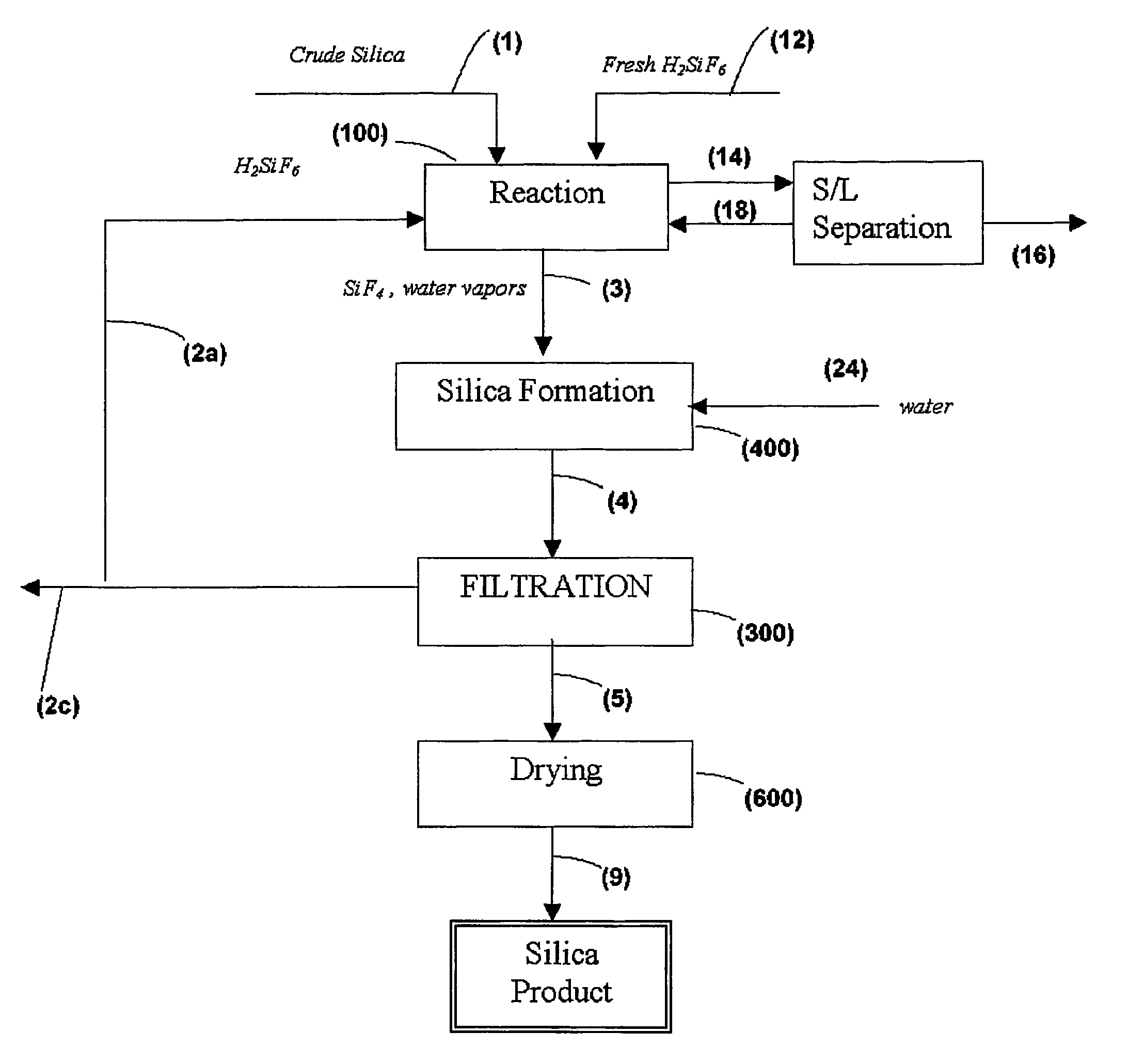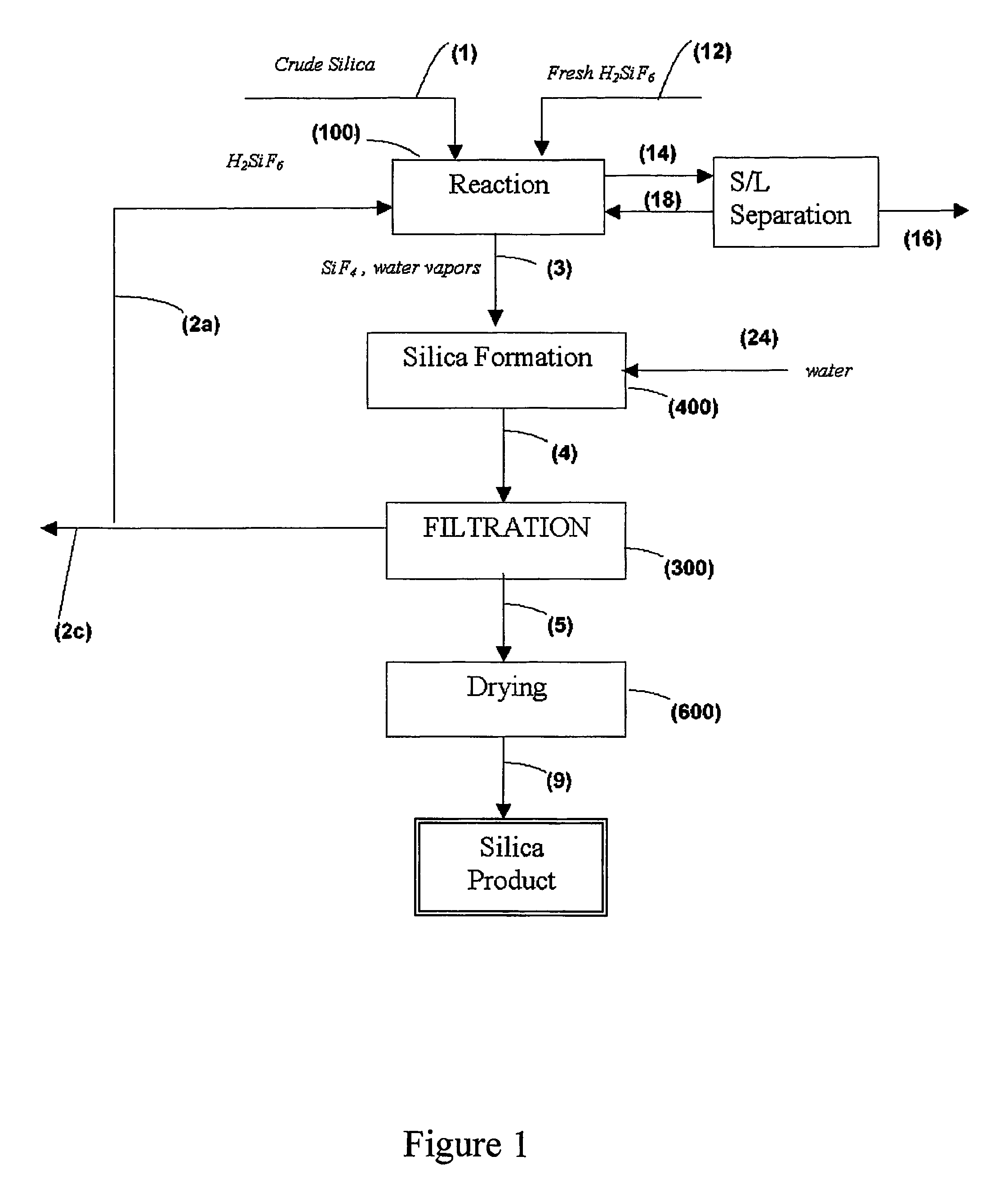Process for the preparation of pure silica
a technology of pure silica and process, applied in the field of producing pure silica, can solve the problems of high cost of process, and contamination of amorphous silica products, and achieve the effect of simple, efficient and cost-effectiv
- Summary
- Abstract
- Description
- Claims
- Application Information
AI Technical Summary
Benefits of technology
Problems solved by technology
Method used
Image
Examples
example 1
[0073]The raw material for the experiment was a clay residue (from a clay initially containing 35.5%, Al2O3, 9.6% Fe2O3, 54.0% SiO2) from which the aluminum oxide was leached by mineral acids at a previous stage at 70° C., whereby 83% of the aluminum oxide was dissolved.
[0074]To 30.0 g of the leached residue were added 50 ml water, and the suspension was treated by adding 66 g of concentrated sulfuric acid by heating for about one hour at 100° C.-110° C. to dissolve the iron and aluminum oxide residues. 150 ml of water were then added, and the suspension was filtered.
[0075]The new residue was washed and dried. To the dry residue, weighing 22.7 g, 445.0 g of fluosilicic acid (24%) were added, and the suspension was evaporated to dryness. After cooling the evaporate, the mixture contained 414 g fluosilicic acid, (23.6% H2SiF6) and precipitated silica. The silica was filtered off, washed and dried. The pure, dry silica obtained weighed 20.6 g, corresponding to approximately 90.7% of th...
example 2
[0078]The experiment was carried out according to Example 1. First, iron and aluminum oxide were removed by the addition of 80 g sulfuric acid. For the reaction with fluosilicic acid, 10% more of the acid was introduced. The slurry was heated for one hour, but was not evaporated to dryness. The yield of silica from the condensate was only 65%, significantly less than in Example 1, due to the reduced heating. The silica obtained was hydrophobic.
[0079]After washing, filtering, drying, and calcining, the product contained better than 99.99% SiO2, on a dry basis. The impurity levels in the product are provided in Table 1.
[0080]It should be emphasized that the bulk of the impurities present in the final product are entrained with the vapors from reaction stage 100, and that a more robust design and control of the system can yield silica of even higher purity.
example 3
[0081]The experiment was carried out with a sample of porcellanite, a silica-containing mineral that is known to accompany phosphate ore fields. The porcellanite used in the experiment contained 56.3.% silica, of which 38% was defined as soluble in caustic soda. The other components of the porcellanite sample include calcium carbonate, calcium phosphate and calcium sulfate, with low concentrations of ferric oxide and aluminum oxide.
[0082]To 25.0 g of the sample were added 50 g of water and 100 g of concentrated hydrochloric acid. The slurry was heated for about one hour to dissolve the carbonate and other soluble residues. The insoluble fraction was filtered off and washed. The weight of the residue, after drying, was 16.1 g, i.e., about 36.6% of the sample dissolved. The silica remained in the insoluble matter.
[0083]To this residue, 378 g of fluosilicic acid (24%) were added. The slurry was heated and evaporated to dryness. The residue left was filtered off and washed. The weight o...
PUM
| Property | Measurement | Unit |
|---|---|---|
| temperature | aaaaa | aaaaa |
| weight ratio | aaaaa | aaaaa |
| weight ratio | aaaaa | aaaaa |
Abstract
Description
Claims
Application Information
 Login to View More
Login to View More - R&D
- Intellectual Property
- Life Sciences
- Materials
- Tech Scout
- Unparalleled Data Quality
- Higher Quality Content
- 60% Fewer Hallucinations
Browse by: Latest US Patents, China's latest patents, Technical Efficacy Thesaurus, Application Domain, Technology Topic, Popular Technical Reports.
© 2025 PatSnap. All rights reserved.Legal|Privacy policy|Modern Slavery Act Transparency Statement|Sitemap|About US| Contact US: help@patsnap.com


